JEEP COMPASS 2019 Owner handbook (in English)
Manufacturer: JEEP, Model Year: 2019, Model line: COMPASS, Model: JEEP COMPASS 2019Pages: 362, PDF Size: 6.23 MB
Page 271 of 362
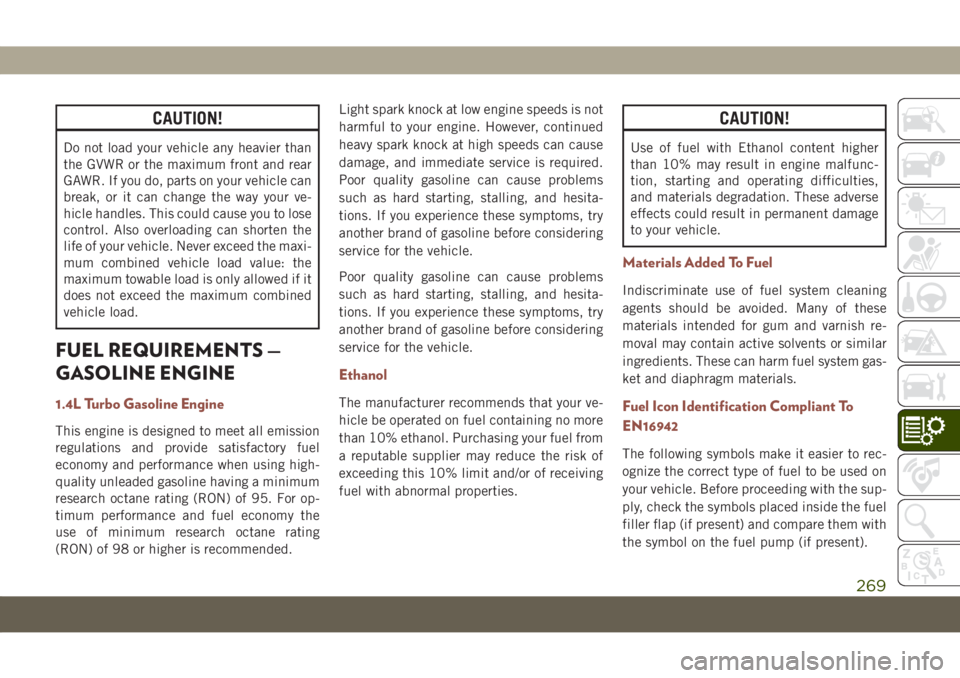
CAUTION!
Do not load your vehicle any heavier than
the GVWR or the maximum front and rear
GAWR. If you do, parts on your vehicle can
break, or it can change the way your ve-
hicle handles. This could cause you to lose
control. Also overloading can shorten the
life of your vehicle. Never exceed the maxi-
mum combined vehicle load value: the
maximum towable load is only allowed if it
does not exceed the maximum combined
vehicle load.
FUEL REQUIREMENTS —
GASOLINE ENGINE
1.4L Turbo Gasoline Engine
This engine is designed to meet all emission
regulations and provide satisfactory fuel
economy and performance when using high-
quality unleaded gasoline having a minimum
research octane rating (RON) of 95. For op-
timum performance and fuel economy the
use of minimum research octane rating
(RON) of 98 or higher is recommended.Light spark knock at low engine speeds is not
harmful to your engine. However, continued
heavy spark knock at high speeds can cause
damage, and immediate service is required.
Poor quality gasoline can cause problems
such as hard starting, stalling, and hesita-
tions. If you experience these symptoms, try
another brand of gasoline before considering
service for the vehicle.
Poor quality gasoline can cause problems
such as hard starting, stalling, and hesita-
tions. If you experience these symptoms, try
another brand of gasoline before considering
service for the vehicle.
Ethanol
The manufacturer recommends that your ve-
hicle be operated on fuel containing no more
than 10% ethanol. Purchasing your fuel from
a reputable supplier may reduce the risk of
exceeding this 10% limit and/or of receiving
fuel with abnormal properties.
CAUTION!
Use of fuel with Ethanol content higher
than 10% may result in engine malfunc-
tion, starting and operating difficulties,
and materials degradation. These adverse
effects could result in permanent damage
to your vehicle.
Materials Added To Fuel
Indiscriminate use of fuel system cleaning
agents should be avoided. Many of these
materials intended for gum and varnish re-
moval may contain active solvents or similar
ingredients. These can harm fuel system gas-
ket and diaphragm materials.
Fuel Icon Identification Compliant To
EN16942
The following symbols make it easier to rec-
ognize the correct type of fuel to be used on
your vehicle. Before proceeding with the sup-
ply, check the symbols placed inside the fuel
filler flap (if present) and compare them with
the symbol on the fuel pump (if present).
269
Page 272 of 362
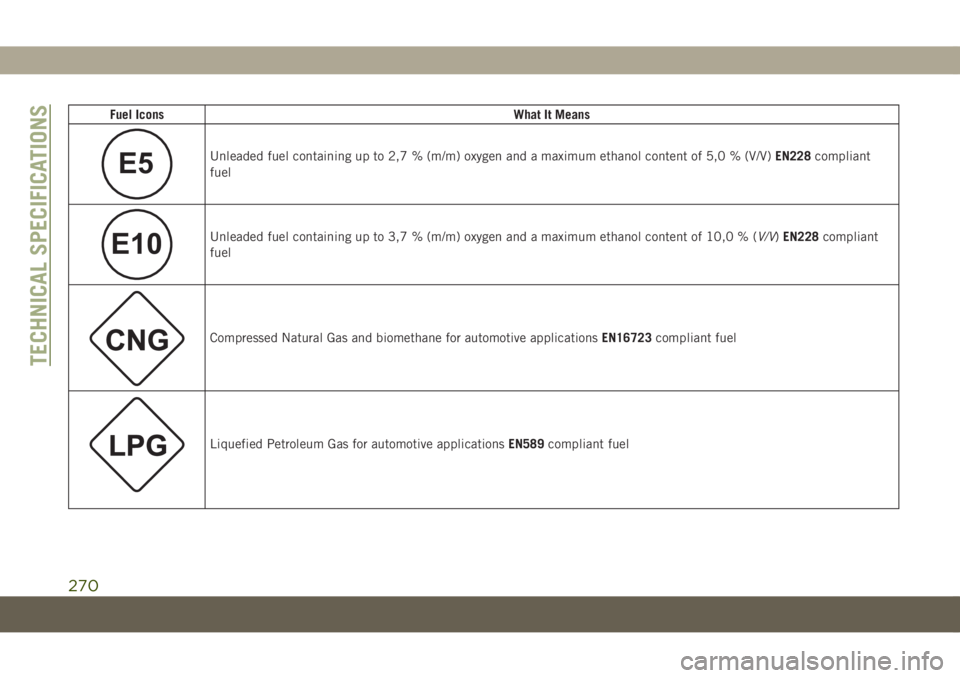
Fuel IconsWhat It Means
E5Unleaded fuel containing up to 2,7 % (m/m) oxygen and a maximum ethanol content of 5,0 % (V/V)EN228compliant
fuel
E10Unleaded fuel containing up to 3,7 % (m/m) oxygen and a maximum ethanol content of 10,0 % (V/V)EN228compliant
fuel
Compressed Natural Gas and biomethane for automotive applicationsEN16723compliant fuel
Liquefied Petroleum Gas for automotive applicationsEN589compliant fuel
TECHNICAL SPECIFICATIONS
270
Page 273 of 362
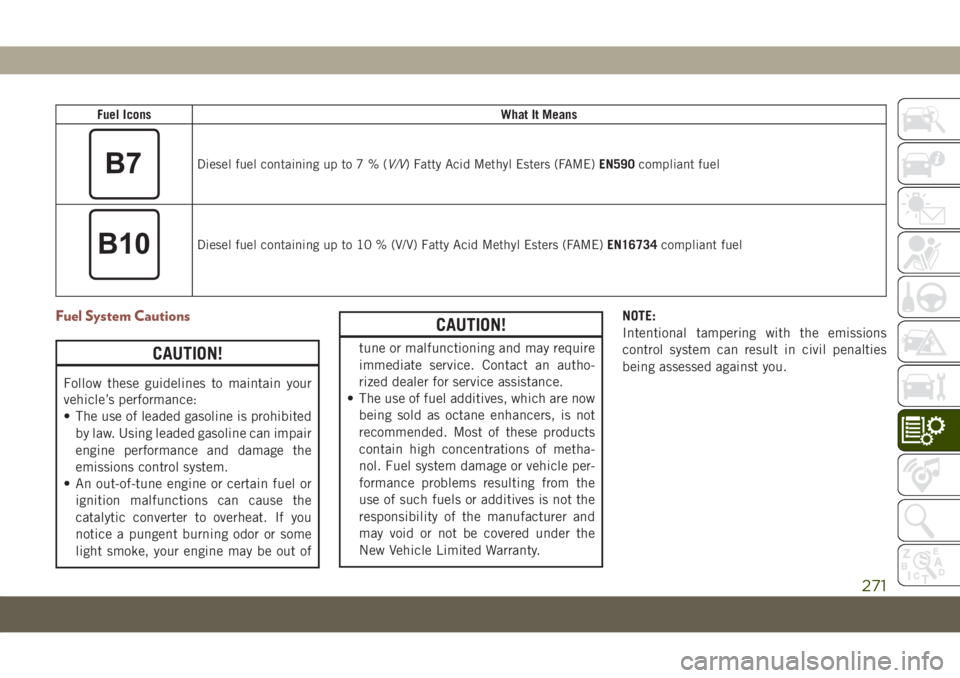
Fuel IconsWhat It Means
Diesel fuel containing up to7%(V/V) Fatty Acid Methyl Esters (FAME)EN590compliant fuel
Diesel fuel containing up to 10 % (V/V) Fatty Acid Methyl Esters (FAME)EN16734compliant fuel
Fuel System Cautions
CAUTION!
Follow these guidelines to maintain your
vehicle’s performance:
• The use of leaded gasoline is prohibited
by law. Using leaded gasoline can impair
engine performance and damage the
emissions control system.
• An out-of-tune engine or certain fuel or
ignition malfunctions can cause the
catalytic converter to overheat. If you
notice a pungent burning odor or some
light smoke, your engine may be out of
CAUTION!
tune or malfunctioning and may require
immediate service. Contact an autho-
rized dealer for service assistance.
• The use of fuel additives, which are now
being sold as octane enhancers, is not
recommended. Most of these products
contain high concentrations of metha-
nol. Fuel system damage or vehicle per-
formance problems resulting from the
use of such fuels or additives is not the
responsibility of the manufacturer and
may void or not be covered under the
New Vehicle Limited Warranty.NOTE:
Intentional tampering with the emissions
control system can result in civil penalties
being assessed against you.
271
Page 274 of 362
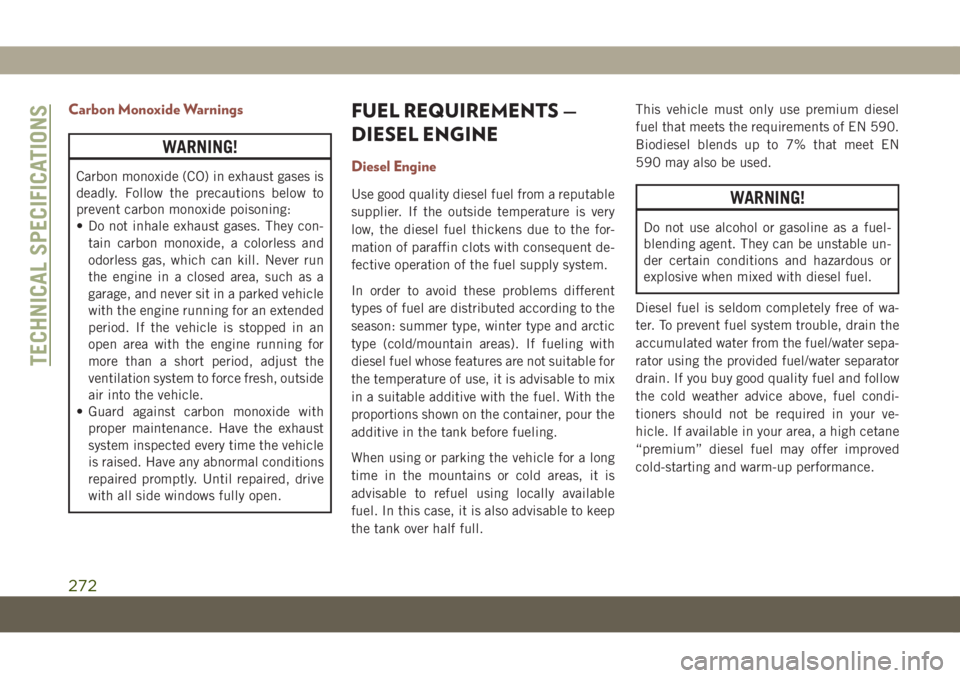
Carbon Monoxide Warnings
WARNING!
Carbon monoxide (CO) in exhaust gases is
deadly. Follow the precautions below to
prevent carbon monoxide poisoning:
• Do not inhale exhaust gases. They con-
tain carbon monoxide, a colorless and
odorless gas, which can kill. Never run
the engine in a closed area, such as a
garage, and never sit in a parked vehicle
with the engine running for an extended
period. If the vehicle is stopped in an
open area with the engine running for
more than a short period, adjust the
ventilation system to force fresh, outside
air into the vehicle.
• Guard against carbon monoxide with
proper maintenance. Have the exhaust
system inspected every time the vehicle
is raised. Have any abnormal conditions
repaired promptly. Until repaired, drive
with all side windows fully open.
FUEL REQUIREMENTS —
DIESEL ENGINE
Diesel Engine
Use good quality diesel fuel from a reputable
supplier. If the outside temperature is very
low, the diesel fuel thickens due to the for-
mation of paraffin clots with consequent de-
fective operation of the fuel supply system.
In order to avoid these problems different
types of fuel are distributed according to the
season: summer type, winter type and arctic
type (cold/mountain areas). If fueling with
diesel fuel whose features are not suitable for
the temperature of use, it is advisable to mix
in a suitable additive with the fuel. With the
proportions shown on the container, pour the
additive in the tank before fueling.
When using or parking the vehicle for a long
time in the mountains or cold areas, it is
advisable to refuel using locally available
fuel. In this case, it is also advisable to keep
the tank over half full.This vehicle must only use premium diesel
fuel that meets the requirements of EN 590.
Biodiesel blends up to 7% that meet EN
590 may also be used.WARNING!
Do not use alcohol or gasoline as a fuel-
blending agent. They can be unstable un-
der certain conditions and hazardous or
explosive when mixed with diesel fuel.
Diesel fuel is seldom completely free of wa-
ter. To prevent fuel system trouble, drain the
accumulated water from the fuel/water sepa-
rator using the provided fuel/water separator
drain. If you buy good quality fuel and follow
the cold weather advice above, fuel condi-
tioners should not be required in your ve-
hicle. If available in your area, a high cetane
“premium” diesel fuel may offer improved
cold-starting and warm-up performance.
TECHNICAL SPECIFICATIONS
272
Page 275 of 362
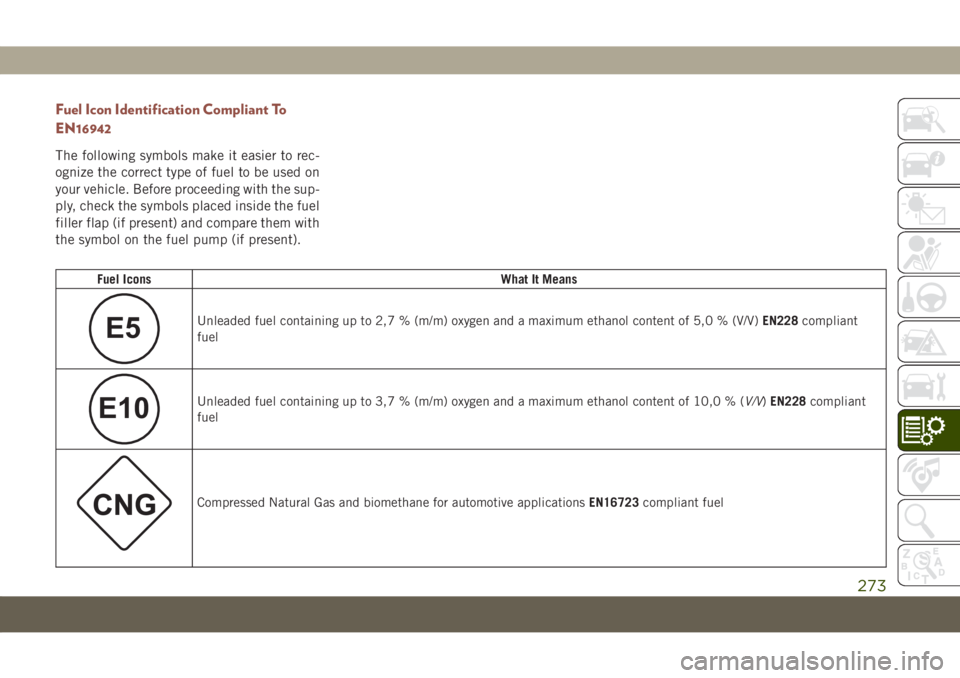
Fuel Icon Identification Compliant To
EN16942
The following symbols make it easier to rec-
ognize the correct type of fuel to be used on
your vehicle. Before proceeding with the sup-
ply, check the symbols placed inside the fuel
filler flap (if present) and compare them with
the symbol on the fuel pump (if present).
Fuel IconsWhat It Means
E5Unleaded fuel containing up to 2,7 % (m/m) oxygen and a maximum ethanol content of 5,0 % (V/V)EN228compliant
fuel
E10Unleaded fuel containing up to 3,7 % (m/m) oxygen and a maximum ethanol content of 10,0 % (V/V)EN228compliant
fuel
Compressed Natural Gas and biomethane for automotive applicationsEN16723compliant fuel
273
Page 276 of 362
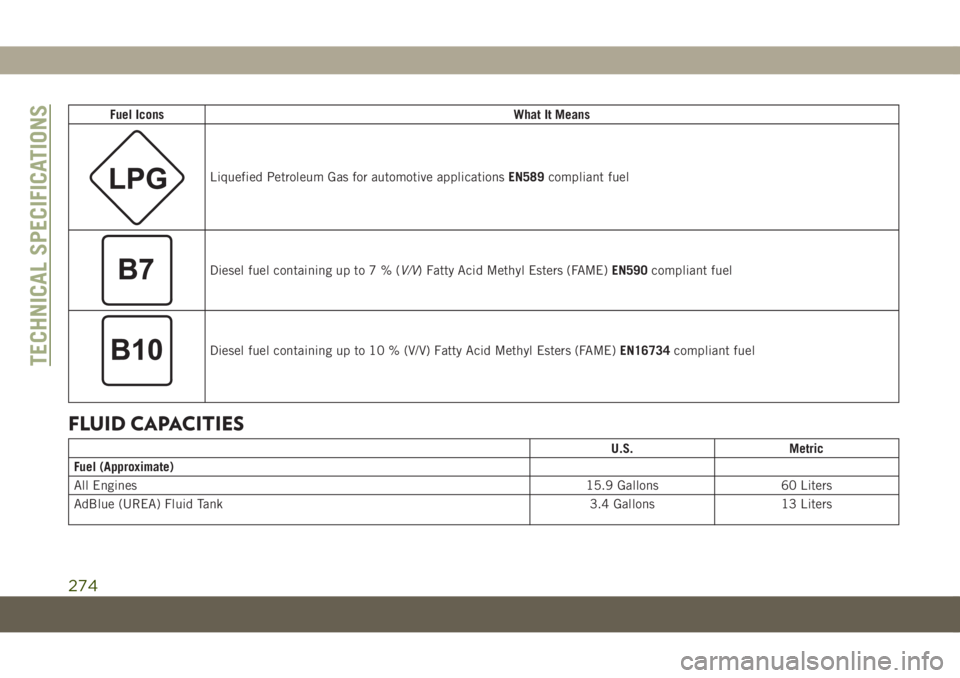
Fuel IconsWhat It Means
Liquefied Petroleum Gas for automotive applicationsEN589compliant fuel
Diesel fuel containing up to7%(V/V) Fatty Acid Methyl Esters (FAME)EN590compliant fuel
Diesel fuel containing up to 10 % (V/V) Fatty Acid Methyl Esters (FAME)EN16734compliant fuel
FLUID CAPACITIES
U.S. Metric
Fuel (Approximate)
All Engines15.9 Gallons 60 Liters
AdBlue (UREA) Fluid Tank 3.4 Gallons 13 Liters
TECHNICAL SPECIFICATIONS
274
Page 277 of 362
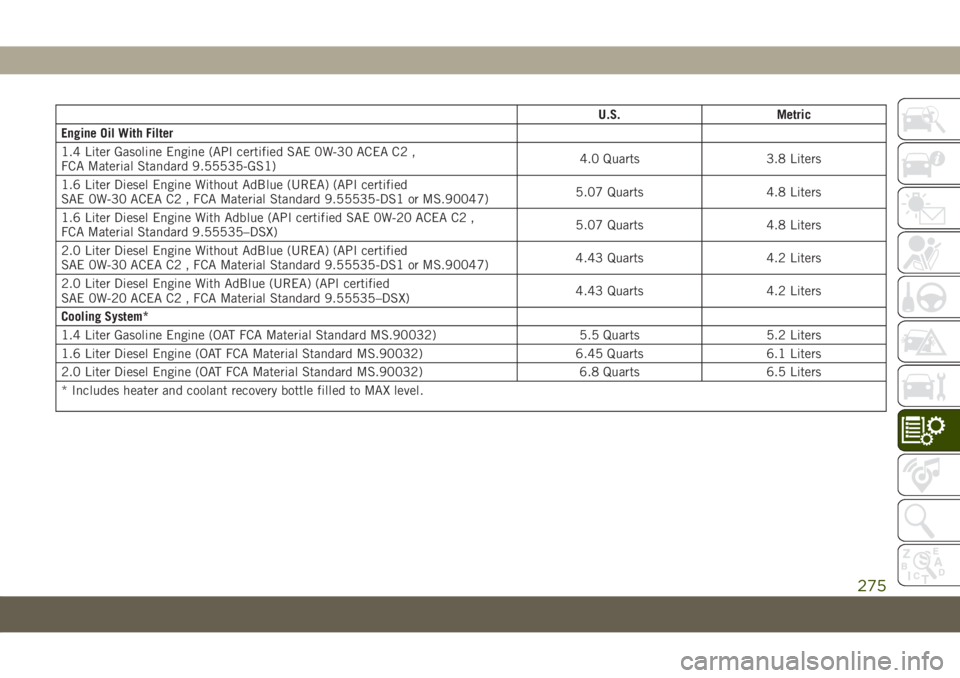
U.S. Metric
Engine Oil With Filter
1.4 Liter Gasoline Engine (API certified SAE 0W-30 ACEA C2 ,
FCA Material Standard 9.55535-GS1)4.0 Quarts 3.8 Liters
1.6 Liter Diesel Engine Without AdBlue (UREA) (API certified
SAE 0W-30 ACEA C2 , FCA Material Standard 9.55535-DS1 or MS.90047)5.07 Quarts 4.8 Liters
1.6 Liter Diesel Engine With Adblue (API certified SAE 0W-20 ACEA C2 ,
FCA Material Standard 9.55535–DSX)5.07 Quarts 4.8 Liters
2.0 Liter Diesel Engine Without AdBlue (UREA) (API certified
SAE 0W-30 ACEA C2 , FCA Material Standard 9.55535-DS1 or MS.90047)4.43 Quarts 4.2 Liters
2.0 Liter Diesel Engine With AdBlue (UREA) (API certified
SAE 0W-20 ACEA C2 , FCA Material Standard 9.55535–DSX)4.43 Quarts 4.2 Liters
Cooling System*
1.4 Liter Gasoline Engine (OAT FCA Material Standard MS.90032) 5.5 Quarts 5.2 Liters
1.6 Liter Diesel Engine (OAT FCA Material Standard MS.90032) 6.45 Quarts 6.1 Liters
2.0 Liter Diesel Engine (OAT FCA Material Standard MS.90032) 6.8 Quarts 6.5 Liters
* Includes heater and coolant recovery bottle filled to MAX level.
275
Page 278 of 362
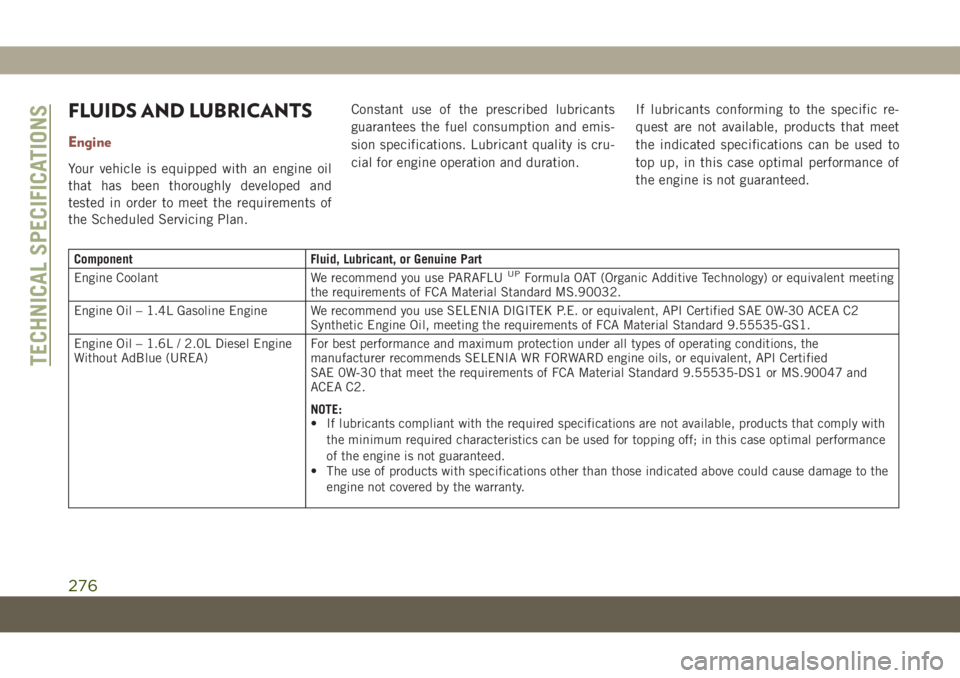
FLUIDS AND LUBRICANTS
Engine
Your vehicle is equipped with an engine oil
that has been thoroughly developed and
tested in order to meet the requirements of
the Scheduled Servicing Plan.Constant use of the prescribed lubricants
guarantees the fuel consumption and emis-
sion specifications. Lubricant quality is cru-
cial for engine operation and duration.If lubricants conforming to the specific re-
quest are not available, products that meet
the indicated specifications can be used to
top up, in this case optimal performance of
the engine is not guaranteed.
Component Fluid, Lubricant, or Genuine Part
Engine Coolant We recommend you use PARAFLUUPFormula OAT (Organic Additive Technology) or equivalent meeting
the requirements of FCA Material Standard MS.90032.
Engine Oil – 1.4L Gasoline Engine We recommend you use SELENIA DIGITEK P.E. or equivalent, API Certified SAE 0W-30 ACEA C2
Synthetic Engine Oil, meeting the requirements of FCA Material Standard 9.55535-GS1.
Engine Oil – 1.6L / 2.0L Diesel Engine
Without AdBlue (UREA)For best performance and maximum protection under all types of operating conditions, the
manufacturer recommends SELENIA WR FORWARD engine oils, or equivalent, API Certified
SAE 0W-30 that meet the requirements of FCA Material Standard 9.55535-DS1 or MS.90047 and
ACEA C2.
NOTE:
• If lubricants compliant with the required specifications are not available, products that comply with
the minimum required characteristics can be used for topping off; in this case optimal performance
of the engine is not guaranteed.
• The use of products with specifications other than those indicated above could cause damage to the
engine not covered by the warranty.
TECHNICAL SPECIFICATIONS
276
Page 279 of 362
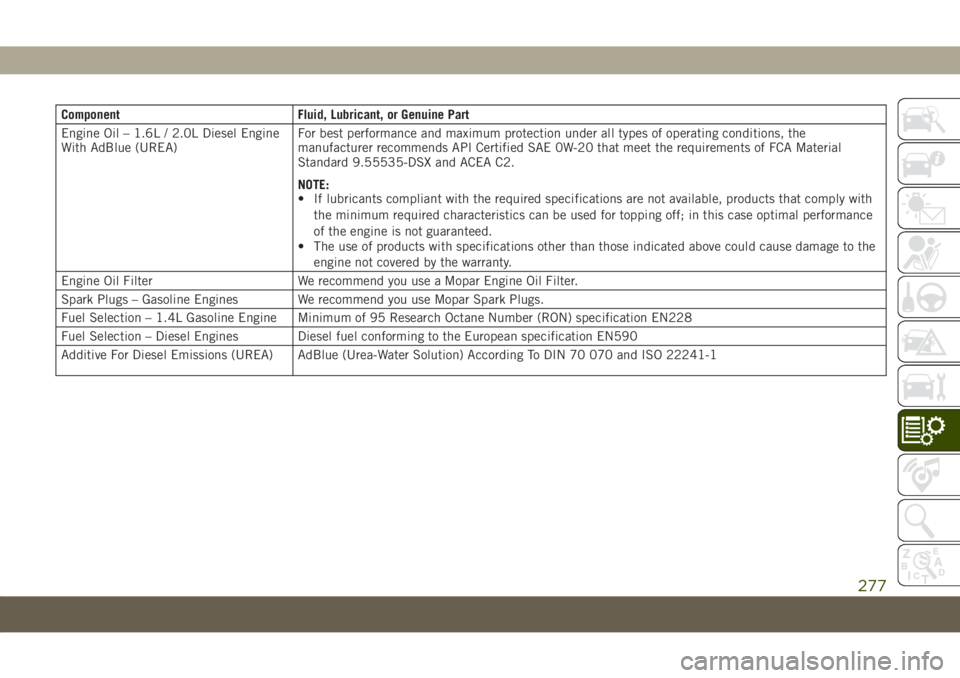
Component Fluid, Lubricant, or Genuine Part
Engine Oil – 1.6L / 2.0L Diesel Engine
With AdBlue (UREA)For best performance and maximum protection under all types of operating conditions, the
manufacturer recommends API Certified SAE 0W-20 that meet the requirements of FCA Material
Standard 9.55535-DSX and ACEA C2.
NOTE:
• If lubricants compliant with the required specifications are not available, products that comply with
the minimum required characteristics can be used for topping off; in this case optimal performance
of the engine is not guaranteed.
• The use of products with specifications other than those indicated above could cause damage to the
engine not covered by the warranty.
Engine Oil Filter We recommend you use a Mopar Engine Oil Filter.
Spark Plugs – Gasoline Engines We recommend you use Mopar Spark Plugs.
Fuel Selection – 1.4L Gasoline Engine Minimum of 95 Research Octane Number (RON) specification EN228
Fuel Selection – Diesel Engines Diesel fuel conforming to the European specification EN590
Additive For Diesel Emissions (UREA) AdBlue (Urea-Water Solution) According To DIN 70 070 and ISO 22241-1
277
Page 280 of 362
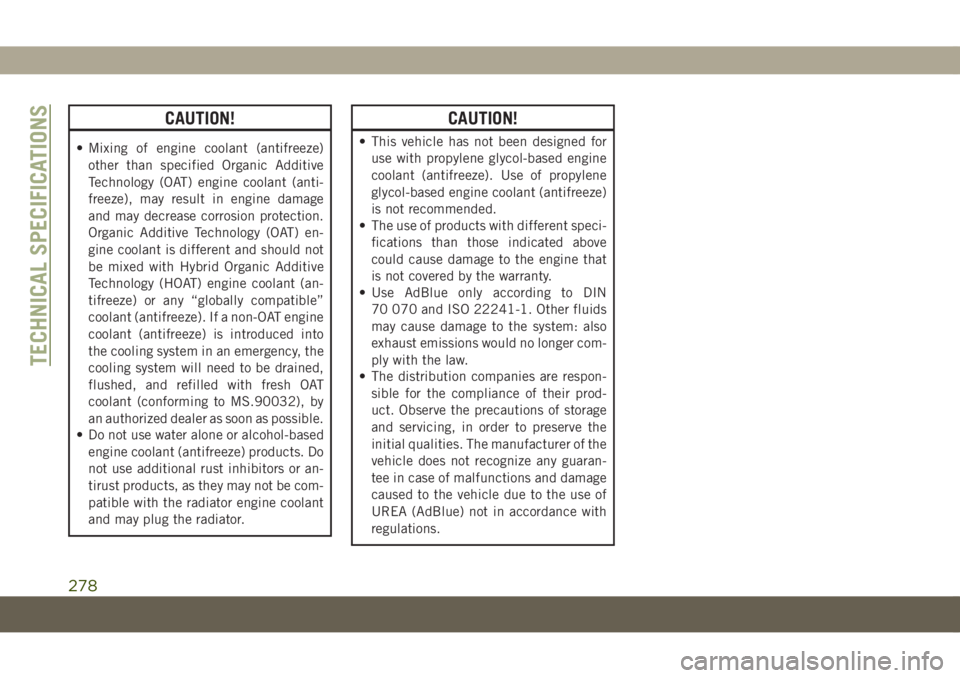
CAUTION!
• Mixing of engine coolant (antifreeze)
other than specified Organic Additive
Technology (OAT) engine coolant (anti-
freeze), may result in engine damage
and may decrease corrosion protection.
Organic Additive Technology (OAT) en-
gine coolant is different and should not
be mixed with Hybrid Organic Additive
Technology (HOAT) engine coolant (an-
tifreeze) or any “globally compatible”
coolant (antifreeze). If a non-OAT engine
coolant (antifreeze) is introduced into
the cooling system in an emergency, the
cooling system will need to be drained,
flushed, and refilled with fresh OAT
coolant (conforming to MS.90032), by
an authorized dealer as soon as possible.
• Do not use water alone or alcohol-based
engine coolant (antifreeze) products. Do
not use additional rust inhibitors or an-
tirust products, as they may not be com-
patible with the radiator engine coolant
and may plug the radiator.
CAUTION!
• This vehicle has not been designed for
use with propylene glycol-based engine
coolant (antifreeze). Use of propylene
glycol-based engine coolant (antifreeze)
is not recommended.
• The use of products with different speci-
fications than those indicated above
could cause damage to the engine that
is not covered by the warranty.
• Use AdBlue only according to DIN
70 070 and ISO 22241-1. Other fluids
may cause damage to the system: also
exhaust emissions would no longer com-
ply with the law.
• The distribution companies are respon-
sible for the compliance of their prod-
uct. Observe the precautions of storage
and servicing, in order to preserve the
initial qualities. The manufacturer of the
vehicle does not recognize any guaran-
tee in case of malfunctions and damage
caused to the vehicle due to the use of
UREA (AdBlue) not in accordance with
regulations.
TECHNICAL SPECIFICATIONS
278